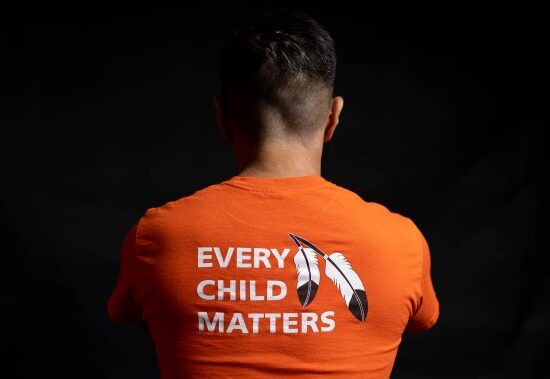
Over a six-week period, as part of the ‘Out of Pocket’ series, Global News is examining how inflation is impacting Canadians from coast to coast.
Chantel Greene, 29, flips through her wall calendar showing a detailed — and bleak — breakdown of expenses each month.
The single mom works full-time managing the car wash and laundromat at Fisher River Cree Nation, 200 kilometers north of Winnipeg.
On that income she supports her father and her 12-year-old daughter Chantay, who has unique needs associated with autism.
Greene has a budget of $1,800. After a truck payment, car insurance, gas, and groceries — she’s in the hole $1,200 to $2,200 each month.
Chantel Greene, 29, flips through her wall calendar showing a detailed breakdown of expenses each month.
As Canadians are feeling more stretched with their budgets, the shock of tough economic times really sinks in when it comes down to necessities like food.
Many are forced to make tough choices in the grip of inflation but for some, like Greene, it means skipping dietary essentials such as protein and fresh vegetables.
“My diet is horrible. I basically eat stuff from a can — like ravioli — or freezer section.”
“I don’t have much fresh food,” Greene said. “Whatever fruits or vegetables I buy I try to get them into my dad.”
Her freezer would be bare if not for a meat package given out by her band at Christmas. It will only last a few weeks.
“With the two adults in the house we made the sacrifice thing,” she said. “We can sacrifice meat, we can sacrifice milk.”
Read more:
10 year study finds ‘extremely high’ rates of First Nations food insecurity
Read next:
Part of the Sun breaks free and forms a strange vortex, baffling scientists
That sacrifice has come with a toll on her and her dad’s health, she believes.
“I definitely think so, because my dad is a renal cancer patient and he also has diabetes and I’ve had my own health issues too, but not as much as the two others in my house,” she said.
Greene adds her daughter has food sensitivities and will only eat a certain kind of brand-name soup.
“That’s the only way I can get her to eat meat and vegetables, so I buy it buy the case,” Greene noted.
There are only a few grocery stores in a one-hour radius from her, so shopping around for bargains on the soup isn’t realistic because she’d be spending those savings on fuel to get there.
Chantay is also lactose-intolerant and two liters of her milk is $7 or more.
Read more:
Inflation has ‘squeezed’ Canadian wallets dry. What happened?
Read next:
Exclusive: Widow’s 911 call before James Smith Cree Nation murders reveals prior violence
Greene says her grocery costs in recent months went from $150 or $200 every two weeks, to $400 or $500 and there’s nowhere in her budget to cut.
A truck is a necessity in the winter to get around where she lives and she says it’s “a struggle” to keep it on the road. All she can do is juggle which bills to pay.
“I can’t remember the last time I bought myself a new sweater — like splurged on something for myself like a sweater,” she said.
“I have no problem buying something for my dad or my daughter or my mom but when it comes to me, I ask is it something I need, or something I want.”
Read more:
Canadian workers’ wages are on the rise
Read next:
Google AI chatbot Bard gives wrong answer, sending shares plummeting
While inflation has had a heavy toll, she is thankful she’s not worse off. She lives in band housing, so doesn’t have rent on top of her expenses. Greene also points out that those on social assistance in her community are struggling even more — living off of as little as $235 a month.
“I take it day by day,” she said, hoping but not expecting inflation relief is in sight. “I grew up budgeting so I’ve been preparing for this my whole life kind of.”
First Nation households ‘struggling’
A 2019 report First Nations Food, Nutrition & Environment Study found 48 per cent of First Nation households in Canada were having difficulty putting enough food on the table, four times above the national average.
The more remote those families were, the worse it would get, with 75 to 80 per cent of families food insecure in some areas, said Malek Batal, Canada Research Chair in Nutrition and Health Inequalities, and one of the lead researchers of the report.
The study found those with children were suffering even worse.
It’s been four years since the report, and with skyrocketing inflation, Batal said in an interview today’s reality would be best described as dire in many communities.
“Things haven’t improved, they would have deteriorated,” he said. “We don’t have those numbers but we’ve heard from communities saying they’re struggling more.”
The study urged the federal government to “urgently address systemic problems relating to food, nutrition and the environment” affecting First Nations communities. A key recommendation was to help improve access to traditional foods like fish and game, which have health, environmental and cultural benefits.
Read more:
Osoyoos Lake sees historic sockeye salmon harvest
Read next:
Netflix Canada begins its password-sharing crackdown. Here’s what to know
Batal points to the success of the Okanagan Nation Alliance which last fall, saw a record salmon harvest after the First Nations restored salmon stocks depleted by development.
The Okanagan Nation Alliance fed eight bands in that B.C. region alone, and Batal said there’s much to learn from this food security and sovereignty success.














